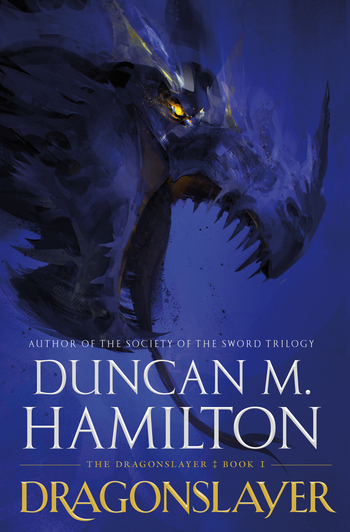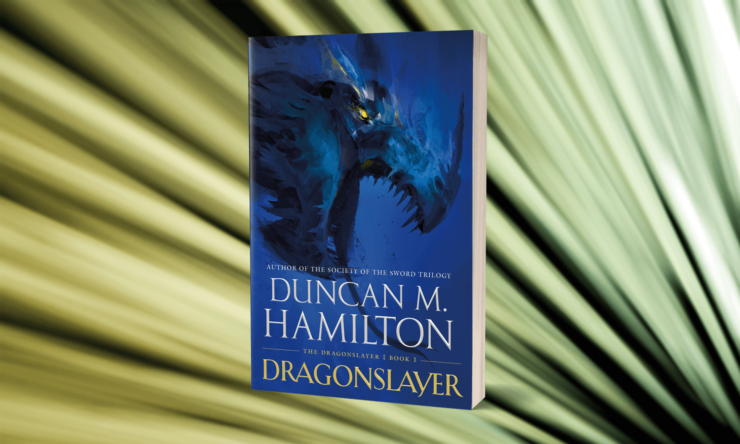When I previously reviewed Howard Andrew Jones’ For the Killing of Kings, I invoked Dumas’ The Three Musketeers as a clear influence on the novel, with a society of users of blades and spells clearly inspired by the Musketeers as a central building block of plot and character development. Dumas’ powerful mix of legend and fact is hardly limited to one author, one novel, or one series, and I am pleased to see other SFF authors taking similar inspiration. So, then, comes Duncan M Hamilton’s Dragonslayer.
Dragonslayer’s secondary world setting feels a lot like a version of Dumas’ 17th century France. The place names of Mirabaya, the kingdom in which the action is set, have a francophone feel: Oudin, the river Vosges, Villerauvais, Rencarneau. Character names similarly invoke Dumas, even in the midst of Hamilton’s invention: Brother-Commander Levarre, Guillot, and Solene.
And the antagonist of the novel clinches the parallel—this is a Musketeers novel in a different world. No, not the dragon Alpheratz, of which I will discuss more later. I am referring to Prince Bishop Amaury del Richeau. An attentive reader can see the name allusion to Cardinal Armand Jean du Plessis, Duke of Richelieu. Or, as fans of the Musketeer novels and movies know him, Cardinal Richelieu. Dragonslayer’s Prince Bishop fits that narrative role admirably, but he is more than just the Cardinal in another guise.
Prince Bishop Armaury has the same powerful political hold over Mirabaya that Richelieu had over France, but a different central animating passion. In the world of Dragonslayer, magic is a forgotten, spent, and even feared force with negative connotations of lost empire—it is forbidden knowledge. Amaury’s single-minded obsession is bringing magic back to prominence, in a way that he can control and use. Frustrated that his own magical ability is minuscule, he has established in secret The Order of the Golden Spur, a school to unlock and study magic to the point where it might be brought out into the open. And in a touch reminiscent of the Musketeer movies more than Dumas’ original novels, Amaury seeks to make his order ascendant over the dissolute and discredited Chevaliers of the Silver Circle, a fallen order of Dragonslayers who, long without dragons to fight, is a shadow of of its former self.
And that brings us to Guillot and Solene.
Guillot, lord of the decaying village of Villerauvais, is himself decaying; once a Chevalier and one of the best swordsmen in Mirabaya, he is now simply a drunk. As he drinks his life away, he cannot even find the motivation to stop a nearby noble from “collecting taxes” from his village. It takes Del Sason, an agent of the Prince Bishop hunting rumors of the reawakened dragon, to finally get Gill to stir. But it takes much more to truly get him on the path of redemption, personal and otherwise. The novel from his point of view IS a story of redemption, an Athos in his cups who has abandoned his duty and has to find the will and personal strength to pick it up again. And not only pick up his duty and live up to his potential, but to exceed it. Because there IS a dragon that needs killing, and although none of the Silver Circle have done so in long decades, it’s Gill’s challenge to pick up.
Our other protagonist and other point of view character is Solene, a young woman who loves to bake bread and—very secretly—can do magic. An incident with a local tough causes her to lash out with her otherwise carefully hidden powers, and she is nearly executed for being a witch when Gill makes a fateful choice to intervene. This sets her on a path to the Prince Bishop, his Order of the Golden Spur, and allows her (and the reader) to gain a deeper understanding of her magic.
Buy the Book


Dragonslayer
But the plot is really kicked off by a dragon, as one might expect. In a world where the last dragon was thought long since dead, Alpharatz’s awakening is a rather fraught event, both for the dragon and the world. Alpharatz’s discovery that he may well be the last dragon in all the world is perhaps the most heart-wrenching plot line of the novel. There is a very nice parallel throughout the book between the Alpharatz and Guillot, the last dragon and the last Chevalier—both have been battered by misfortune, mischance, and the actions of others. Caught in machinations beyond their control and by their own natures, there is a poignancy in the encounters they share together.
The novel is fast-paced, a brisk and quick read. I might have hoped for a bit more balance in some of the point of view choices, and Part Three of the book is much shorter compared to the previous two sections. But I was never looking to see how much more of the book was left, rather how much more reading I could squeeze in rat a time. Dragonslayer’s rich world, taking inspiration from the “Great Wall of Europe”, is one that the author clearly has a lot of love for. I look forward to Hamilton’s future efforts in this series (the forthcoming Knight of the Silver Circle and Servant of the Crown) to see where he brings the world and its characters.
Dragonslayer is available from Tor Books.
Read the first three chapters of the novel here.
An ex-pat New Yorker living in Minnesota, Paul Weimer has been reading sci-fi and fantasy for over 30 years. An avid and enthusiastic amateur photographer, blogger and podcaster, Paul primarily contributes to the Skiffy and Fanty Show as blogger and podcaster, and the SFF Audio podcast. If you’ve spent any time reading about SFF online, you’ve probably read one of his blog comments or tweets (he’s @PrinceJvstin).










